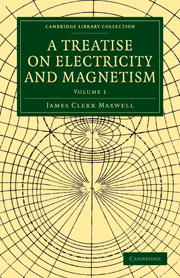Book contents
- Frontmatter
- PREFACE
- Contents
- ELECTRICITY AND MAGNETISM
- PRELIMINARY
- PART I ELECTROSTATICS
- CHAPTER I DESCRIPTION OF PHENOMENA
- CHAPTER II ELEMENTARY MATHEMATICAL THEORY OF ELECTRICITY
- CHAPTER III SYSTEMS OF CONDUCTORS
- CHAPTER IV GENERAL THEOREMS
- CHAPTER V MECHANICAL ACTION BETWEEN ELECTRIFIED BODIES
- CHAPTER VI POINTS AND LINES OF EQUILIBRIUM
- CHAPTER VII FORMS OF EQUIPOTENTIAL SURFACES AND LINES OF FLOW
- CHAPTER VIII SIMPLE CASES OF ELECTRIFICATION
- CHAPTER IX SPHERICAL HARMONICS
- CHAPTER X CONFOCAL SURFACES OF THE SECOND DEGREE
- CHAPTER XI THEORY OF ELECTRIC IMAGES
- CHAPTER XII CONJUGATE FUNCTIONS IN TWO DIMENSIONS
- CHAPTER XIII ELECTROSTATIC INSTRUMENTS
- PART II ELECTROKINEMATICS
- Plate section
CHAPTER II - ELEMENTARY MATHEMATICAL THEORY OF ELECTRICITY
Published online by Cambridge University Press: 05 July 2011
- Frontmatter
- PREFACE
- Contents
- ELECTRICITY AND MAGNETISM
- PRELIMINARY
- PART I ELECTROSTATICS
- CHAPTER I DESCRIPTION OF PHENOMENA
- CHAPTER II ELEMENTARY MATHEMATICAL THEORY OF ELECTRICITY
- CHAPTER III SYSTEMS OF CONDUCTORS
- CHAPTER IV GENERAL THEOREMS
- CHAPTER V MECHANICAL ACTION BETWEEN ELECTRIFIED BODIES
- CHAPTER VI POINTS AND LINES OF EQUILIBRIUM
- CHAPTER VII FORMS OF EQUIPOTENTIAL SURFACES AND LINES OF FLOW
- CHAPTER VIII SIMPLE CASES OF ELECTRIFICATION
- CHAPTER IX SPHERICAL HARMONICS
- CHAPTER X CONFOCAL SURFACES OF THE SECOND DEGREE
- CHAPTER XI THEORY OF ELECTRIC IMAGES
- CHAPTER XII CONJUGATE FUNCTIONS IN TWO DIMENSIONS
- CHAPTER XIII ELECTROSTATIC INSTRUMENTS
- PART II ELECTROKINEMATICS
- Plate section
Summary
Definition of Electricity as a Mathematical Quantity
63.] We have seen that the actions of electrified bodies are such that the electrification of one body may be equal to that of another, or to the sum of the electrifications of two bodies, and that when two bodies are equally and oppositely electrified they have no electrical effect on external bodies when placed together within a closed insulated conducting vessel. We may express all these results in a concise and consistent manner by describing an electrified body as charged with a certain quantity of electricity, which we may denote by e. When the electrification is positive, that is, according to the usual convention, vitreous, e will be a positive quantity. When the electrification is negative or resinous, e will be negative, and the quantity −e may be interpreted either as a negative quantity of vitreous electricity or as a positive quantity of resinous electricity.
The effect of adding together two equal and opposite charges of electricity, +e and −e, is to produce a state of no electrification expressed by zero. We may therefore regard a body not electrified as virtually charged with equal and opposite charges of indefinite magnitude, and an electrified body as virtually charged with unequal quantities of positive and negative electricity, the algebraic sum of these charges constituting the observed electrification.
- Type
- Chapter
- Information
- A Treatise on Electricity and Magnetism , pp. 66 - 87Publisher: Cambridge University PressPrint publication year: 2010First published in: 1873



